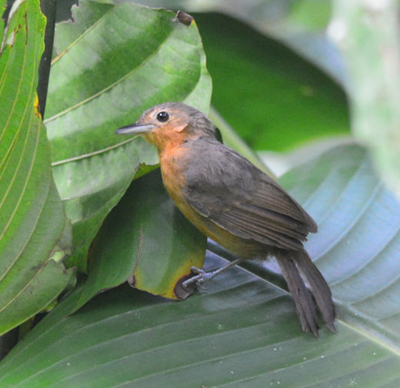- Cercomacroides tyrannina
Identification
13·5–14·5 cm (5¼-5¾ in)
Male
- Grey to blackish upperparts
- Lower parts paler in some subspecies
- Two white wing bars
- Tiny white tip to tail
- Young males for the first year has a subdued plumage
Female
- Brown above
- Rufous-cinnamon below
Both sexes possess a white area on the back that is normally covered, but which can be revealed in territorial display.
Variation
Subspecies varies in how dark the male is, from almost black to pale grey in Brazil. Subspecies saturatior which is very dark will show white fringes to feathers on the belly.
Similar species
Blackish Antbird overlaps in range in the Guianas; Jet Antbird in Panama
Distribution
From southeastern Mexico through Central America to Panama; in South America west of Andes to western Ecuador, in northern Colombia, and east of the andes in the lowlands north of Amazon river to The Guianas and Brazil.
Taxonomy
Formerly placed in genus Cercomacra.
Subspecies
Four subspecies are recognized[1]:
- C. t. crepera:
- C. t. tyrannina:
- C. t. vicina:
- Eastern slope of Eastern Andes of northern Colombia and north-western Venezuela
- C. t. vicina:
- The Guianas and north-eastern Amazonian Brazil
Habitat
Lowland and foothill evergreen forests, forest edges, clearings and stream edges. Generally in dense understorey.
Behaviour
Breeding
A deep, small cup shaped nest is built from plant material and dead leaves. The clutch consists of 2 white eggs with red brown spots. Both adults incubate and raise the young.
The youngsters will stay on their parents territory for almost a year, until the start of next breeding season, unless a vacancy appears in a nearby territory.
Diet
The diet consists of a variety of insects, including beetles, wasps and some larvae.
Vocalisation
Call: whistled kick
Song: male - pu pu pe pi pi the female responds with juu-ut juu-ut juu-ut juu-ut juu-ut.
References
- Clements, J. F., T. S. Schulenberg, M. J. Iliff, D. Roberson, T. A. Fredericks, B. L. Sullivan, and C. L. Wood. 2017. The eBird/Clements checklist of birds of the world: v2017, with updates to August 2017. Downloaded from http://www.birds.cornell.edu/clementschecklist/download/
- Restall et al. 2006. Birds of Northern South America. Yale University Press. ISBN 9780300124156
- Morton & Stutchbury (2001): Behavioral Ecology of Tropical Birds. Academic Press. ISBN 0-12-675556-6
- Ridgely and Tudor 2009. Field guide to the songbirds of South America - The Passerines. University of Texas Press. ISBN 978-0-292-71979-8
- Handbook of the Birds of the World Alive (retrieved August 2017)
- Wikipedia
Recommended Citation
- BirdForum Opus contributors. (2024) Dusky Antbird. In: BirdForum, the forum for wild birds and birding. Retrieved 15 May 2024 from https://www.birdforum.net/opus/Dusky_Antbird





